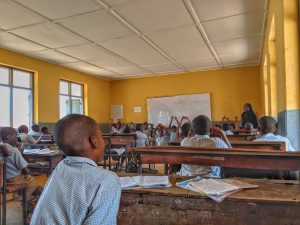Investing in the Future of Education
March 16, 2022527 views0 comments
According to the Journal of African Economies, countries across Africa are facing a number of challenges with regards to education. In examining recent studies on how to improve the quality of learning across the continent, researchers found the need to intervene and invest at every level, from early child education onwards. Some of the promising interventions they’ve found to yield long-term gains include teacher training initiatives, new student materials, school feeding schemes, and eliminating school fees, to name a few. Ultimately, the study highlights how quality education can only come about with sufficient support and investment across sectors. In this article, we’ll take a look at three ways African countries can invest in the future of education:
Investing in teachers
The International Task Force on Teachers for Education 2030 projects that sub-Saharan Africa will need as many as 15 million teachers to reach education goals by 2030. More and smarter investments are necessary to recruit this target number of new teachers, train qualified professionals, and retain those who are already teaching. Unfortunately, even when countries already cover most education costs, teachers in low-income areas still need external financial support to fund essential, non-salary expenses like professional development, blended learning training, access to ICT, and better working conditions.
As the COVID-19 pandemic unveiled, teachers cannot support learning continuity without receiving support in turn. Their heavy workloads and low salaries are a recipe for burnout, so more financing is key to meeting those needs. Aside from working to improve those aforementioned areas, institutions should ensure teachers’ health and safety moving forward, as well as provide socio-emotional assistance to continue a positive educational trajectory.
Investing in technologies
The pandemic hastened the need for schools to stay resilient and flexible, which has been done mostly by harnessing the power of technology. Aside from the development of learning management solutions, Africa also witnessed a dramatic take-up of mobile devices over the years, which helped provide education in hard-to-reach regions. Case in point, Bridge Uganda School leverages cutting-edge technology and innovations to provide students with a high-quality education, even if they cannot physically be present in class. Teaching guides display lessons, track pacing, and record assessment scores in near real time using dedicated software, allowing them to check on pupil comprehension from home.
In the future, technologies will allow schools to identify inefficiencies and weak spots through data. Artificial intelligence could potentially be used to assess students’ writing and speaking skills online, for example. However, teachers must be at the heart of decision-making here. Vikas Pota, founder of T4 Education and the Teacher Tech Summit, pointed out how teachers are rarely invited to be part of the discussion surrounding educational technology. With technology being introduced in classrooms, it’s crucial to let teachers take centre stage and collaborate on best practices for learning.
Investing in students
Spending and student learning are tangled together more than we realise. Some studies have found that additional resources spent on education have led to improved graduation rates and better life outcomes. This, perhaps, is why the private sector invests heavily in scholarships. For instance, the corporate social responsibility arm of the United Bank of Africa (UBA) — recently awarded an educational grant of N3 million to Eziaku Esther, a student of His Grace High School, Enugu State, after winning the foundation’s eleventh annual National Essay Competition. Aside from educational grants to the top winners, UBA also provided laptops, books, and other learning materials as consolation prizes.
Investing in students requires policy development and incentives to provide less-advantaged African students the best chance at education. Government must invest in books, materials, equipment, and facilities like science labs and computers for a holistic education. Strong curriculum opportunities, such as coding, robotics, and mother tongue programmes, are a step in the right direction as well.

